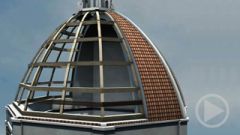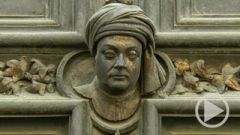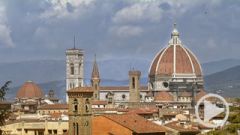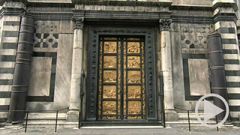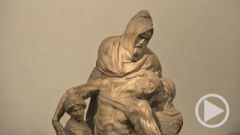- Home
- »
- Welcome
- »
- Italy
- »
- Florence
- »
- Florence Cathedral
- »
- Florence Cathedral - Fathers of the Renaissance
Fathers of the Renaissance
Fathers of the Renaissance
Lorenzo Ghiberti & Donatello
Not that Lorenzo Ghiberti is just anybody – he’s one of the most famous artists in Florence. And the same year, 1425, he celebrates a triumph of his own: He’s completed the new doors for the baptistery – the very commission he once won against Filippo.
Just like Andrea Pisano did before, Lorenzo has also subdivided the doors into 28 sections. At the bottom he depicts the church fathers and the four evangelists. In the 20 sections above those, he relates scenes from the life of Christ – this time, from bottom to top. At the start, the archangel Gabriel announces the birth of Christ to Mary. In the following panel, the Christmas story is portrayed – an angel also appears to the shepherds in the fields. As the storytelling continues, viewers move their gazes steadily skywards. The climax eventually comes right at the top: the passion of Christ – his crucifixion – the resurrection – and finally the Pentecost.

Lorenzo has also included a small portrait of himself. He is now 40 years old, and at the pinnacle of his fame. The new doors meet with unanimous admiration. Lorenzo is immediately awarded the commission for the third portal – this time without any need for a contest. Filippo Brunelleschi is not even considered for the job.
But in the years that follow, Filippo’s role as chief architect is undisputed. Lorenzo is primarily concerned with the cathedral windows. No comparable cycle of glass paintings is produced in Italy in either the 14th or 15th centuries. The windows in the nave depict various saints from the Old and New Testaments. The saints to whom the cathedral is dedicated maintain a glowing presence in the chapels around the choir. The round windows in the tambour are devoted to Jesus and Mary. Alongside Lorenzo Ghiberti, some of the city’s greatest artists are also working on the 44 windows – among them Paolo Uccello, Andrea del Castagno – and Donatello.
Filippo’s old friend has in the meantime become the most respected sculptor in Florence. For the façade and the campanile of the cathedral he created statues that completely altered the evolution of sculpture. They are among the cathedral’s most valuable works of art. To protect them from environmental damage, the statues displayed on the tower today are copies – created in the sculpture workshop of the Opera del Duomo. The master craftsmen here work just as Donatello himself did more than half a millennium ago.

Donatello’s sculptures are now on show in the museum, where it’s clearly evident just how radical they were at the time: The old, Gothic statues are idealised, they symbolically portray certain functions – for example “the prophet”. Donatello on the other hand shows people, such as the prophet Habakuk, fondly named “pumpkin head” by the Florentines. The prophet Jeremiah also looks like a real person – it’s said that a friend of Donatello’s modelled for this piece.
Just as Giotto’s paintings had done, Donatello’s sculptures ushered in the Renaissance period. His style became exemplary for generations of artists. It also conveyed a new spiritual message: Donatello shows that even the prophets and apostles were people – just like the people of Florence who looked upon the statues, day in, day out. This makes them a perpetual source of encouragement: if they are faithful, even ordinary people can become saints. This is the basic conviction to which the entire cathedral of Florence is dedicated. Donatello creates one of his most poignant statues for the Baptistry: the Magdalena. She is portrayed as a rueful sinner, covered only by her long hair. Donatello’s statue makes her suffering almost physically tangible – and appears strikingly modern even today.
In total contrast is the singing gallery that he designs for the cathedral, just as the dome is nearing completion. Donatello’s colleague Luca della Robbia has already created a gallery. In its reliefs children sing and play in praise of god, just as it states in Psalm 150: “Praise him with timbrel and dancing; Praise him with stringed instruments and pipe!” Luca’s design adheres completely to traditional forms. But Donatello disregards those constraints and allows the children to run riot along the entire length of the gallery, even unceremoniously breaking through the boundaries of individual sections.


